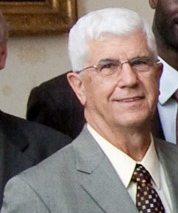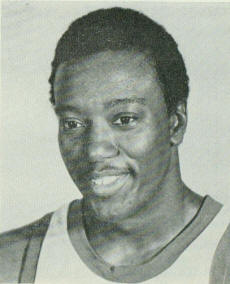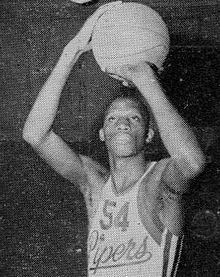
Willis Reed Jr. was an American professional basketball player, coach, and general manager. He spent his entire ten-year pro playing career (1964–1974) with the New York Knicks of the National Basketball Association (NBA). Reed was a seven-time NBA All-Star and five-time All-NBA selection, including once on the first team in 1970, when he was named the NBA Most Valuable Player (MVP). He was a two-time NBA champion and was voted the NBA Finals MVP both times. In 1982, Reed was inducted into the Naismith Memorial Basketball Hall of Fame. He was named to both the NBA's 50th and 75th anniversary teams.

Arild Verner Agerskov Mikkelsen was an American professional basketball player. One of the National Basketball Association's first power forwards in the 1950s, he was known for his tenacious defense. Also an ironman, he played in 699 out of a possible 704 during his career. He was a six-time All-Star and four-time Second Team All-Pro, and was inducted into the NAIA Basketball Hall of Fame and the sport's Naismith Memorial Basketball Hall of Fame in 1995.

Delmer William Harris is an American basketball coach who is currently the vice president of the Texas Legends, the NBA G League affiliate of the Dallas Mavericks. He served as a head coach for the NBA's Houston Rockets, Milwaukee Bucks, and Los Angeles Lakers, as well as the Legends. He was also an assistant coach for the National Basketball Association's New Jersey Nets, Chicago Bulls, Dallas Mavericks, Milwaukee Bucks, and the Houston Rockets.

Zelmo "Big Z" Beaty was an American basketball player. He played eight seasons in the National Basketball Association (NBA) and four in the rival American Basketball Association (ABA). A three-time ABA All-Star and two-time NBA All-Star, Beaty was inducted into the Naismith Memorial Basketball Hall of Fame as a player in 2016.

Robert Louis Boozer was an American professional basketball player in the National Basketball Association (NBA). Boozer won a gold medal in the 1960 Summer Olympics and won an NBA Championship as a member of the Milwaukee Bucks in 1971. Boozer was a member of the 1960 U.S. Olympic team, which was inducted into the Naismith Basketball Hall of Fame as a unit in 2010.

Bailey E. Howell is an American former professional basketball player. After playing college basketball at Mississippi State, Howell played 12 seasons in the National Basketball Association (NBA). Howell was a six-time NBA All-Star, two-time NBA champion and was inducted into the Naismith Memorial Basketball Hall of Fame in 1997.
John B. McLendon Jr. was an American basketball coach who is recognized as the first African American basketball coach at a predominantly white university and the first African American head coach in any professional sport. He was a major contributor to the development of modern basketball and coached on both the college and professional levels during his career. He has been enshrined three times in the Naismith Memorial Basketball Hall of Fame, and also inducted into the National Collegiate Basketball Hall of Fame.
The following are the basketball events of the year 1999 throughout the world.
The following are the basketball events of the year 1998 throughout the world.
The 1960 NBA draft was the 14th annual draft of the National Basketball Association (NBA). The draft was held on April 11, 1960, before the 1960–61 season. In this draft, eight NBA teams took turns selecting amateur U.S. college basketball players. A player who had finished his four-year college eligibility was eligible for selection. If a player left college early, he would not be eligible for selection until his college class graduated. In each round, the teams select in reverse order of their win–loss record in the previous season. Before the draft, a team could forfeit its first-round draft pick and then select any player from within a 50-mile radius of its home arena as their territorial pick. The Minneapolis Lakers participated in the draft, but relocated to Los Angeles and became the Los Angeles Lakers prior to the start of the season. The draft consisted of 21 rounds comprising 100 players selected.

The Cleveland Pipers were an American industrial basketball team based in Cleveland, Ohio in the 1950s and early 1960s. The Pipers are mostly known for having played in the short-lived American Basketball League from 1961–62. They were also a power in the day's Amateur Athletic Union (AAU) basketball and the National Industrial Basketball League (NIBL) which peaked in the late 1950s and early 1960s.

John Anthony "Rabbit" Barnhill was an American professional basketball player.
The following are the basketball events of the year 2008 throughout the world.
The following are the basketball events of the year 2009 throughout the world.

The Prairie View A&M Panthers basketball team is the men's basketball team that represents Prairie View A&M University in Prairie View, Texas, United States. The school's team currently competes in the Southwestern Athletic Conference (SWAC). PVAMU won the 1962 NAIA Tournament.
The following are the basketball events of the year 2012 throughout the world.

The Tennessee State Tigers basketball team represents Tennessee State University (TSU) in Nashville, Tennessee, United States. The school's team currently competes in the NCAA Division I's Ohio Valley Conference. They play their home games at the Gentry Complex and are led by sixth-year head coach Brian "Penny" Collins.
The 1957–58 Tennessee A&I State Tigers basketball team represented Tennessee A&I State College in National Association of Intercollegiate Athletics (NAIA) men's basketball during the 1957–58 season. Coached by fourth-year head coach John McLendon, the Tigers finished the season with a 31–3 record and were crowned NAIA national champions by winning the 1958 NAIA tournament. This marked the second of three consecutive national championships, a feat that no other team at any level of college basketball had previously accomplished. In 2019, all three national championship teams were inducted into the Naismith Memorial Basketball Hall of Fame.
The 1956–57 Tennessee A&I State Tigers basketball team represented Tennessee A&I State College in National Association of Intercollegiate Athletics (NAIA) men's basketball during the 1956–57 season. Coached by third-year head coach John McLendon, the Tigers finished the season with a 31–4 record and were crowned NAIA national champions by winning the 1957 NAIA tournament. This marked the first of three consecutive national championships, a feat that no other team at any level of college basketball had previously accomplished. In addition, the 1956–57 team became the first historically black college to win a national basketball title. In 2019, all three national championship teams were inducted into the Naismith Memorial Basketball Hall of Fame.
The 1958–59 Tennessee A&I State Tigers basketball team represented Tennessee A&I State College in National Association of Intercollegiate Athletics (NAIA) men's basketball during the 1958–59 season. Coached by fifth-year head coach John McLendon, the Tigers finished the season with a school-record 32 wins and were crowned NAIA national champions by winning the 1959 NAIA tournament. This marked the third of three consecutive national championships, a feat that no other team at any level of college basketball had previously accomplished. In 2019, all three national championship teams were inducted into the Naismith Memorial Basketball Hall of Fame.









